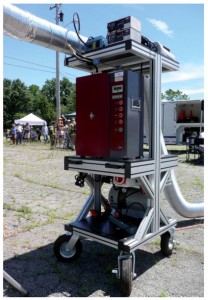There are 200,000 cars fires every year in the United States. The number in the UK is even more impressive: 100,000 car fires every year (which means around 300 fires a day). Car fires are usually short, but also very intense, and release dangerous products that may not only pollute the environment, but also seriously affect the firemen tackling them. Despite the high incidence of this type of fires, very few studies have addressed the hazardous exposures firemen may be suffering.
Two researchers from Cincinnati (Ohio) have published a paper in Environmental Science: Processes & Impacts investigating the dangers of ultrafine and respirable particles released during vehicle fire suppression. They set three different cars on fire and asked a crew of firemen to suppress them with water. Meanwhile, a huge “vacuum cleaner”-like machine took samples that were later analysed by the two scientists.
The particle emissions were, like the fires, only present for a short period of time. However, the concentrations measured during the blaze were orders of magnitude bigger than the safe limits. They also found that cabin fire suppression is more dangerous than putting out just the engine compartment. The explanation might be simple: when the whole cabin is burning down, there is more fuel feeding the combustion, leading to more emissions and longer extinction times.
Another key aspect to consider is wind. Usually fire crews are trained to position themselves in an upwind and smoke-free spot, but you can’t control wind. When wind veered, particle emissions went off the chart, consequently increasing the risks.
Further studies will be carried out. In the meantime, the authors conclude that a self-contained breathing apparatus (a mask that works with compressed air generating a positive pressure inside it) should be worn throughout all the phases of extinguishing a vehicle fire. Otherwise, the hazardous vapours and particles released to the atmosphere may increase the risk of cancer in firemen.
Click on the link below to read the full article for free*
Ultrafine and respirable particle exposure during vehicle fire suppression
Douglas E. Evans and Kenneth W. Fent
Environ. Sci.: Processes Impacts, 2015, 17, 1749-1759
DOI: 10.1039/C5EM00233H
—————-
Fernando Gomollón-Bel is a PhD Student at the ISQCH (CSIC–University of Zaragoza). His research focuses on asymmetric organic synthesis using sugars as chiral-pool starting materials towards the production of fungical transglycosidase inhibitors.
—————-
* Access is free through a registered RSC account.












